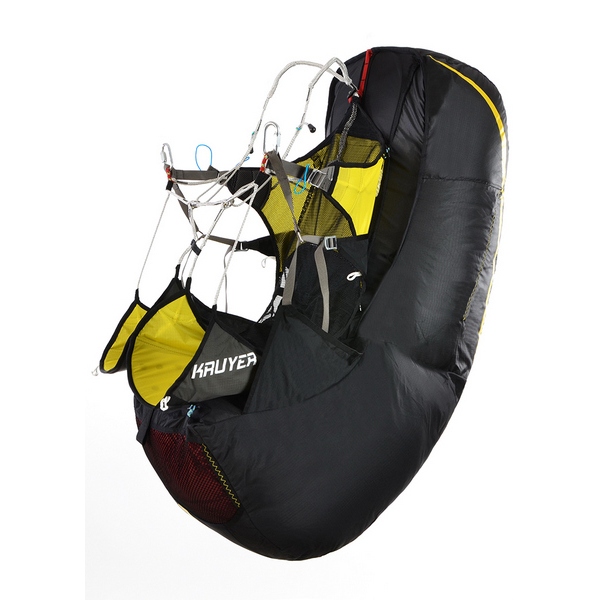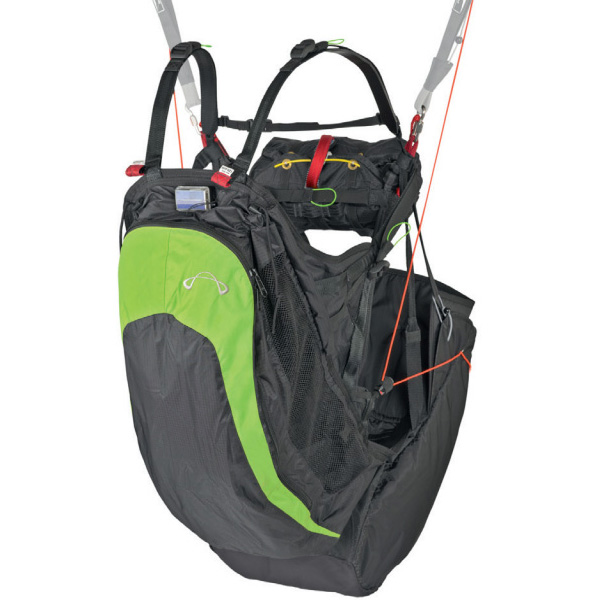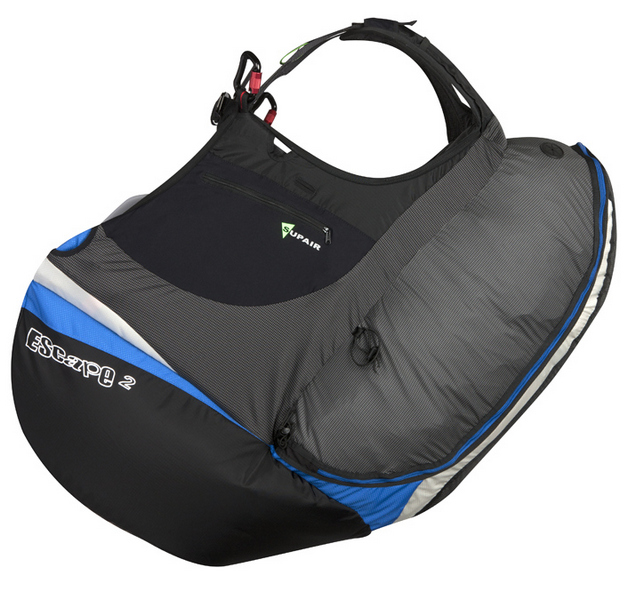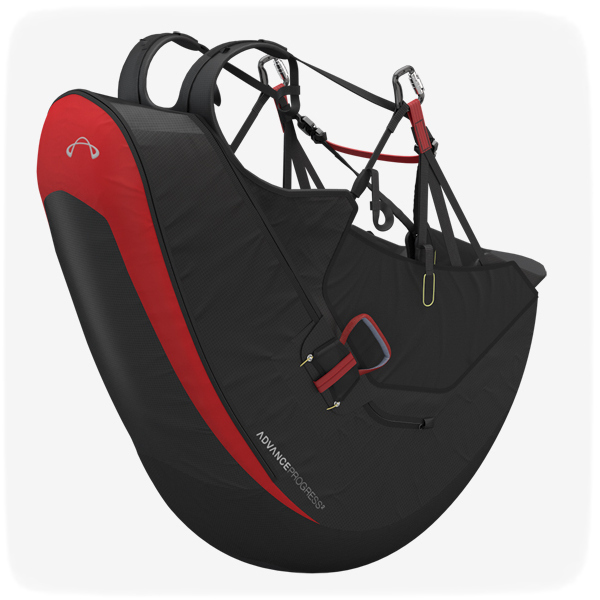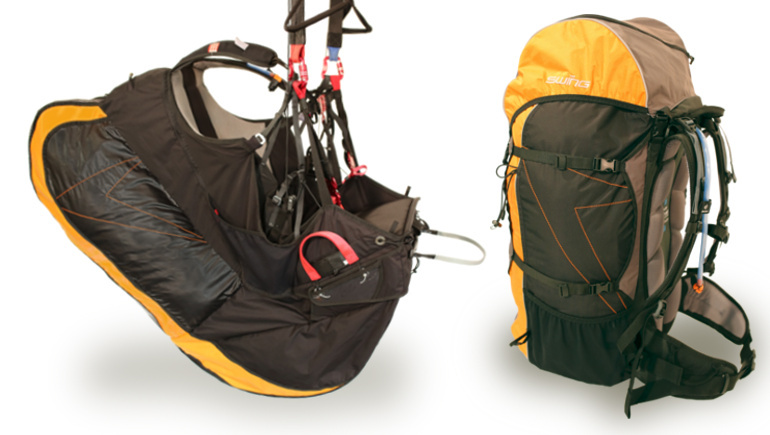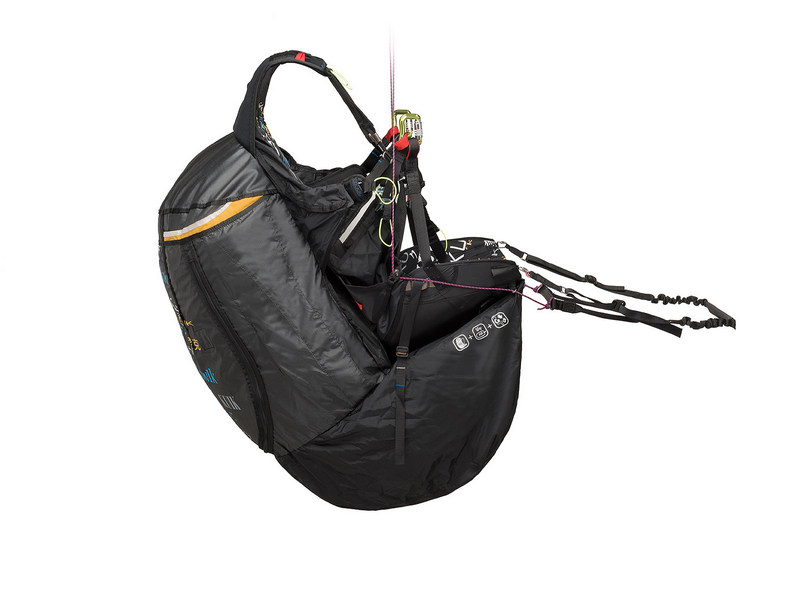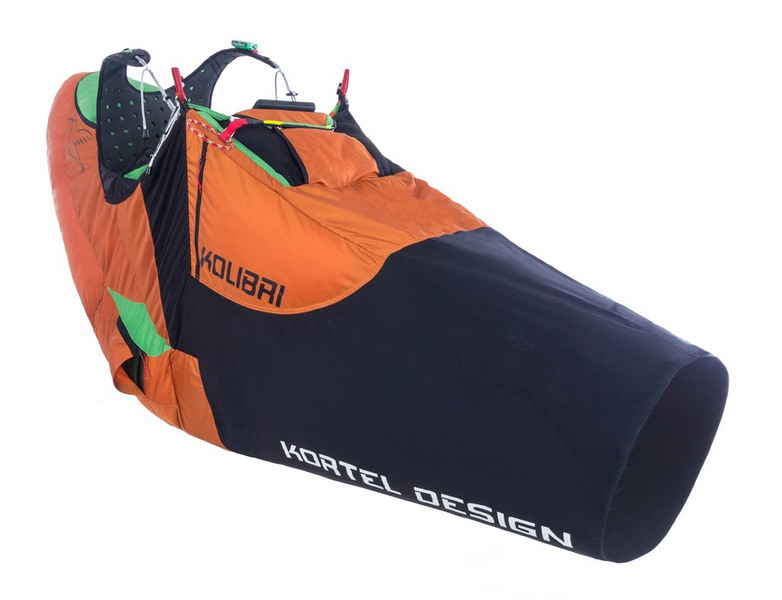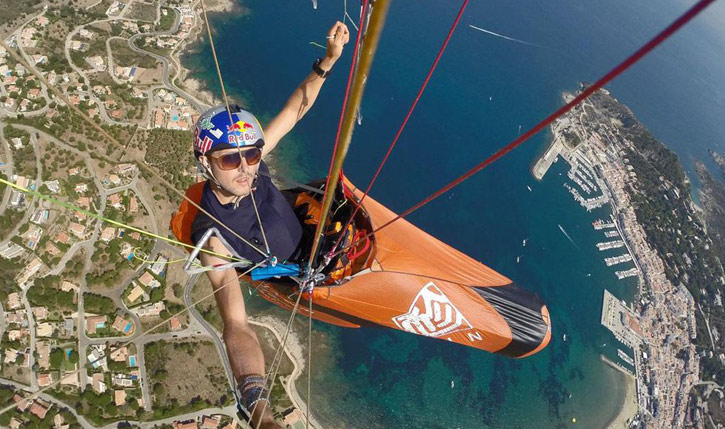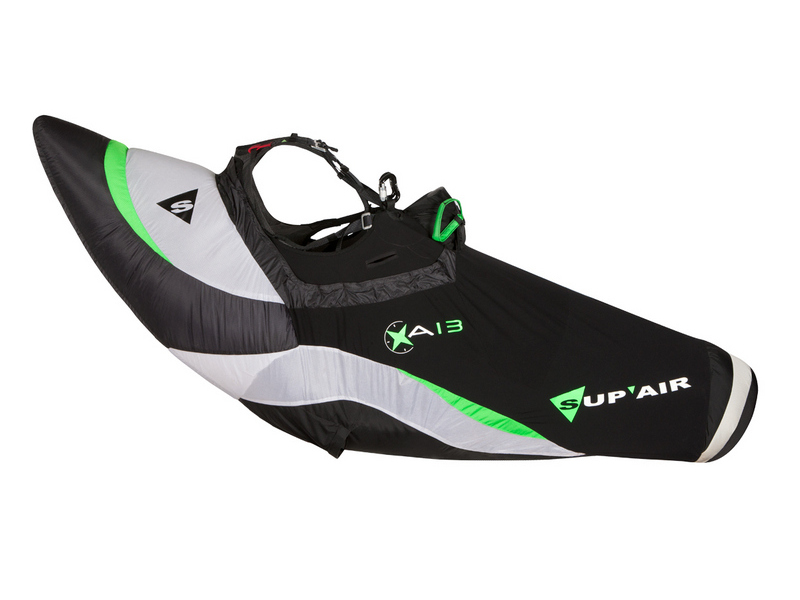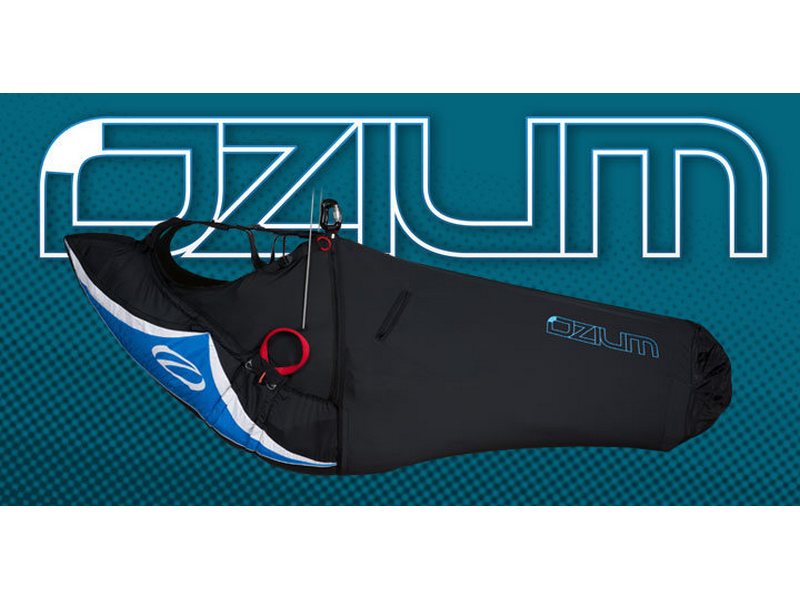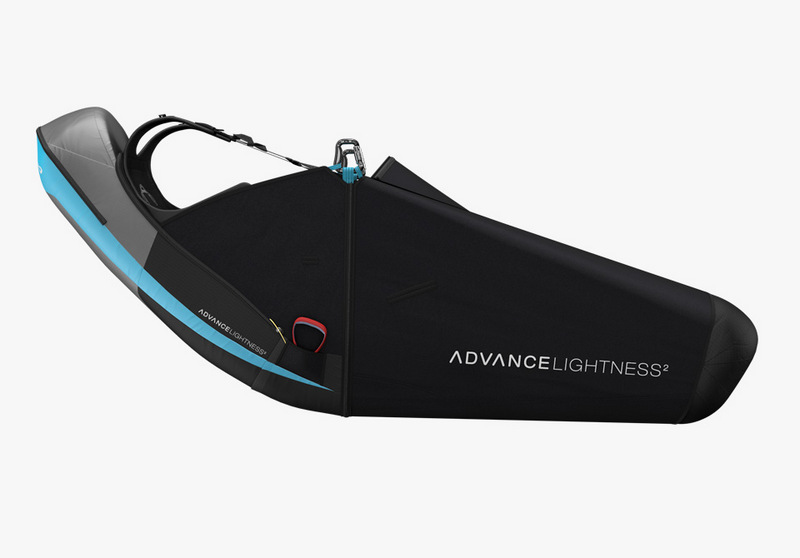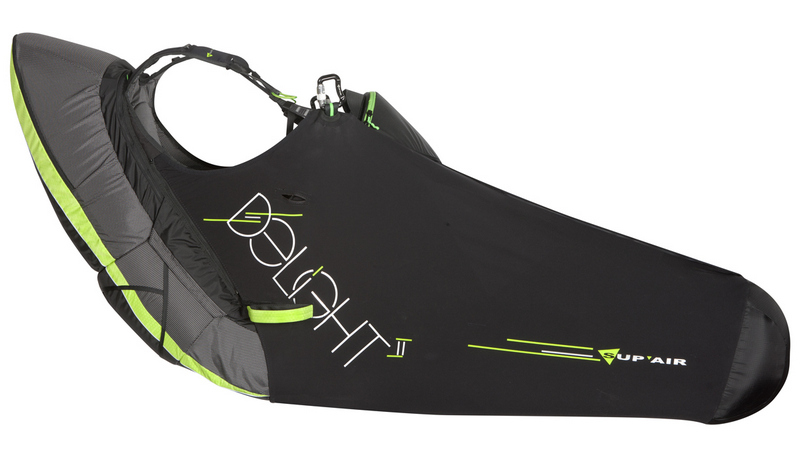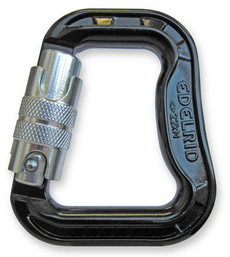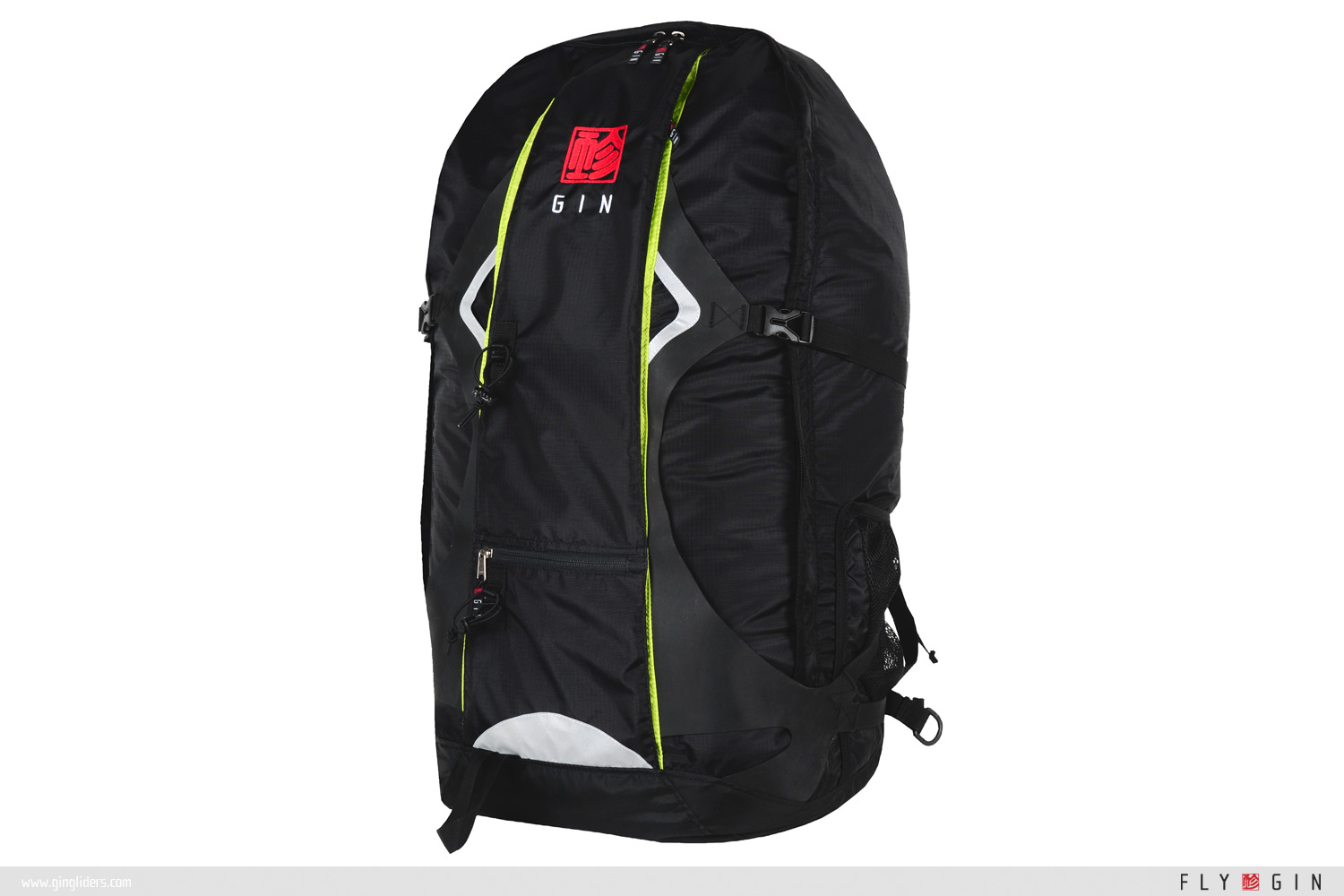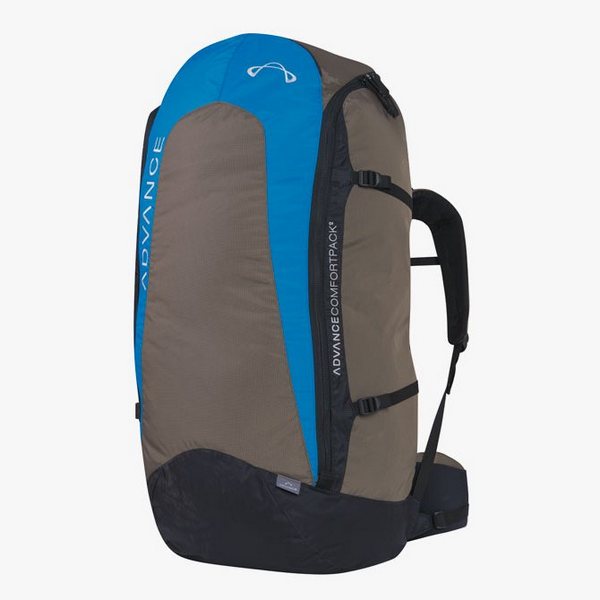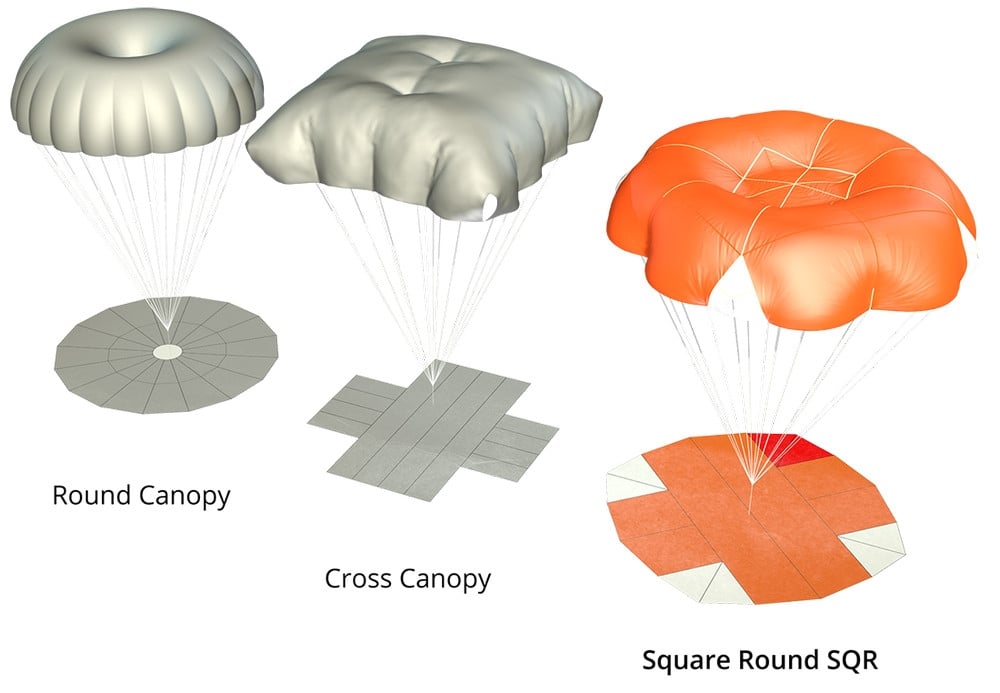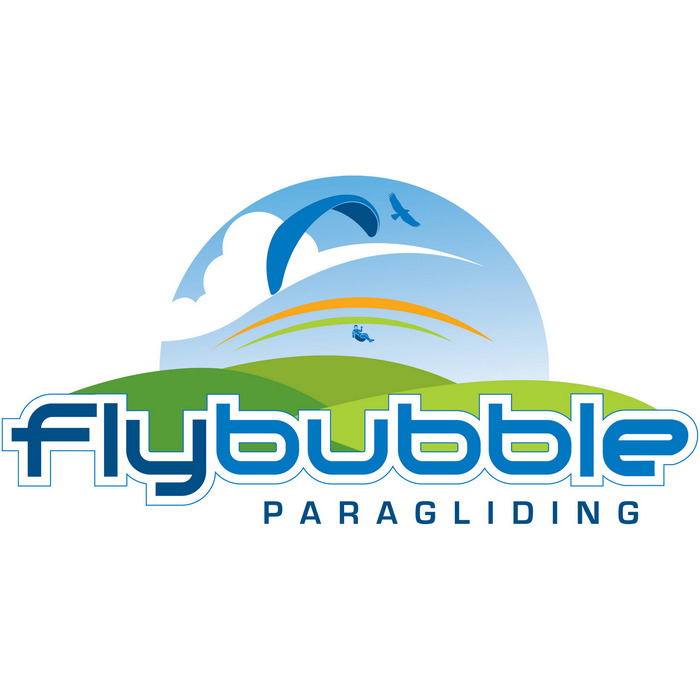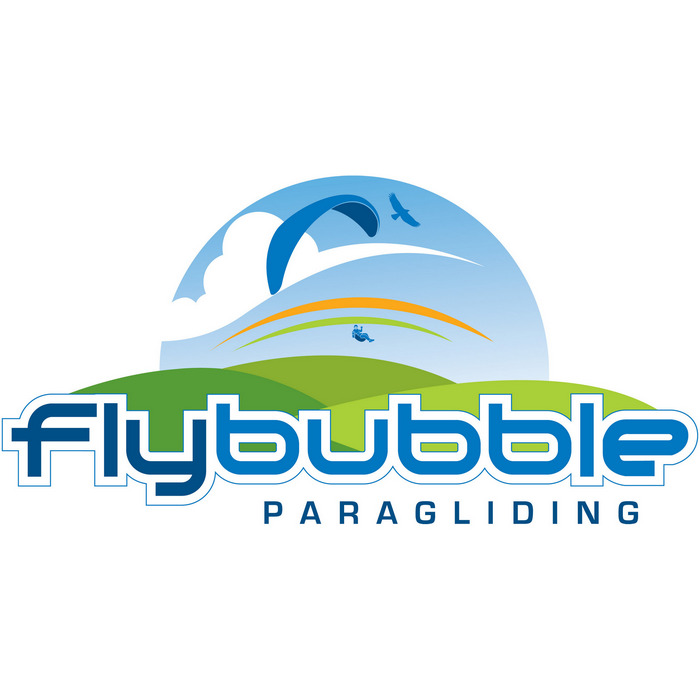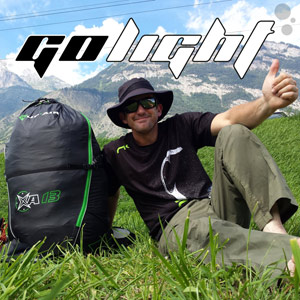
Lightweight kit makes you more adventurous when going cross country. It inspires you to hike up peaks, just to fly down. It packs down small and makes travel a pleasure.
In this article we will try to assemble a complete lightweight flying solution that offers you the best from the latest designs.
We will consider harnesses, backpacks, reserves, helmets, instruments and wings; all the elements that combine to form an ideal lightweight kit.
Go Light: Overview
When you're going to walk any distance with your paraglider, your total kit weight becomes critical. Lightweight kit makes you more adventurous when going cross country. It inspires you to hike up peaks, just to fly down. It packs down small and makes travel a pleasure.
So it is great to see that specialised fabrics, minimalistic designs and even the weight-optimised gear of the X-Alps race have filtered into the catalogues of many freeflight manufacturers.
However, most pilots can only afford to have one complete flying kit. If your flying is limited to the area near the site (hike up, fly down) then you can go superlight with the simplest of harnesses, but most lightweight enthusiasts want to enjoy a range of flying: some hike-and-fly, some soaring, some cross country and the occasional bivi in the back country.
In this article we will try to assemble a complete lightweight flying solution that offers you the best from the latest designs.
We will consider harnesses, backpacks, reserves, helmets, instruments and wings; all the elements that combine to form an ideal lightweight kit.
When looking at harnesses, we have ignored the almost-weightless systems with no certified back protection, and have tried to include appropriate carabiner and speedbar weights to allow for easy comparison, using the medium sizes. Likewise, uncertified wing or helmet designs have been ignored.
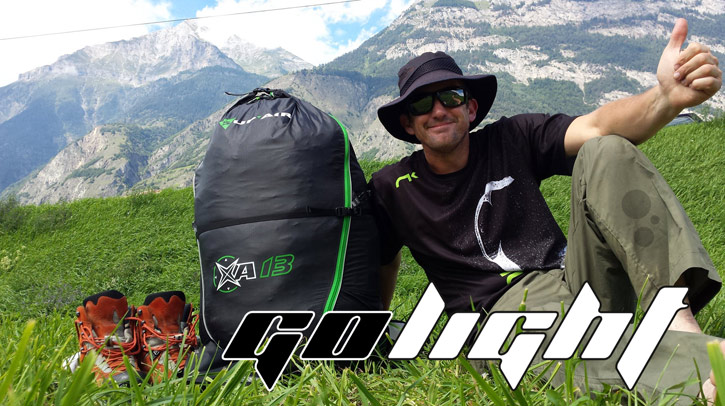
Go Light: Harnesses
Mountain Harnesses
The 'alpine-ascent' systems in this category (mountain harnesses) are the lightest possible way to safely hang from a paraglider.
320g: Kortel Kruyer II offers some comfort and is what we’d recommend as the base module for an extremely light solution.
+985g: add the Sak II airbag/backpack combination
+194g: with a front mount reserve container
+20g: and lightweight speedbar
Total weight: 1519g.
That’s a pretty complete system, and remember it includes the weight of the small backpack, as do the following alternatives (all including harness, rucksack, airbag, reserve container, speedbar and karabiners):
+-1970g Advance Easiness
+- 2014g Skywalk FLEX system
+-2100g Gin Yeti Convertible 2014
But all these are designed for lightweight/mini wings which pack down small. If you’re flying a full sized paraglider or doing any kind of adventuring, you’ll need an extra backpack, which will dangle off your back when flying, stuffed with the extra gear. Not ideal.
So most pilots will need to step up to the slightly heavier lightweight reversible harnesses with better bag volume.
Lightweight Reversible Harnesses
All weights are including reversible harness-rucksack, airbag, reserve container, speedbar and carabiners:
2640g Sup’Air Escape 2 is a split leg airbag harness. The front mount reserve container and cockpit aren't integrated.
3500g Advance Progress 2 has an integrated reserve container and airbag
3850g Swing Connect Reverse Evo has excellent carrying comfort and many well-designed features.
3854g Kortel Kuik II (Core) with Sak Module is extremely comfortable and has a unique modular concept
Some pilots enjoy the knees-in-the-breeze simplicity of these harnesses, but there’s a more efficient lightweight solution if you have some experience (50hrs+ would be our recommendation): a pod harness offers more comfort for long flights and will keep you warmer. This allows you to reduce your clothing weight which compensates for the added weight of the backpack. A big benefit is that you can get the ideal sized backpack for your style of flying or adventure, and there’s no compromise in either the bag or harness design as they are separate items.
Ultralight Pod Harnesses
1890g Kortel Kolibri The best option for bivi specialists, this has great packing space (fits a lot in the back pouch, and can take a ballast bag, sleeping bag and mat in the base). Comfortable and great balance in the air, good hybrid protection. It’s awkward to get into and needs some modifications so it’s not for everyone, but gram-counters and back-country cowboys will love it.
+-2000g Gin Genie X-Alps Durable dyneema fabric covering, clean design. A large mousse bag offers a wide area of protection on launch. Easy-to-access back pouch is suitable for normal use but offers limited space for bivi gear, however the mousse bag area could be repurposed. Nice cockpit, superb build quality, very simple.
2220g Sup'Air XA 13 The way they have combined the airbag and mousse bag offers one of the most complete protection systems in this class. Comfortable, with a moderate rear storage pouch suitable for normal XC. No under-seat storage area, unless you remove the mousse bag.
2256g Skywalk Range Air has a very large airbag protector with incredible 20G protection, an extensive aerodynamic cone to the rear for improved efficiency, and yet it packs down really small. A back storage pouch that will take a large bivi load but there’s no possibility of shifting a heavy water-bag under the seat for better balance. The quoted weight assumes you replace the included 152g Charly carabiners with 24g Supair Connects (to allow like for like comparison in this class).
Lightweight Pod Harnesses
If you’re willing to carry a little more weight, you progress from ‘race’ harnesses to ones designed for regular XC use, while still being light. The rear-mounted integrated reserve makes them simple to use (all the ultralight pods have front-mounted reserves). The storage in these standard harnesses is adequate for normal XC flying, but will be a squeeze if you have tent, sleeping bag, cooker and food.
2610g Ozone Ozium Comfortable, moderate packing space to rear and small pouch under the seat for ballast. Rather basic straps and finishing, and the cockpit is fiddly.
2800g: Advance Lightness 2 Comfortable, durable, very sleek. Large mousse foam protection. Moderate rear storage pouch and underseat ballast pouch. Adaptable cockpit. Excellent design!
3660g: Sup'Air Delight 2 removable mini-seatplate so you can choose what style of flying you prefer. Large mousse foam protection. Removable speedbag, so for summer, beach flying, or hike and fly, you can reduce the weight. Has a moderate rear storage pouch and underseat ballast pouch.
Go Light: Karabiners
You can save a little weight for karabiners by using dyneema (string) connectors, which are incredibly strong but quite fiddly to set up, especially if you get a twist on the slope and try to re-attach in the cold. Only consider this if you are confident with tying knots/rigging. This is not a good option if you often swop wings, or have a habit of disconnecting from your wing when packing.
24g (pair) Sup'Air Connects
Most pilots will find normal karabiners much easier to use:
116g (pair) Advance Karabiners
Go Light: Backpacks
Carrying comfort and packing volume are important when it comes to choosing a lightweight rucksack. If you are doing multi-day adventures with a standard wing and an ultralight pod harness, you’ll need at least 100L.
740g 100L Sup'Air XA13 bag is less than half the weight of a normal paragliding backpack, so well worth the expense. We tested the smaller 90L bag (weighed at 696g), with careful packing it held all our bivi equipment for a week in the Alps, which was impressive as we were using a standard sized wing and a bivi bag (no sleeping bag or cooker). After adjusting the straps, it carries well and has an excellent range of accessible pockets.
+-800g 90L Advance LIGHTPACK 2 (coming soon, only with LIGHTNESS 2). We expect great geometry and carrying comfort as it’s based on the new COMFORTPACK. Enough space for normal XC, a bit limited for bivi.

900g 90L Gin Light Rucksack
There are smaller options if you have minimalistic hike-and-fly-down kit, for example:
580g 80L Skywalk Backpack HIKE (also 55L 480g)
550g 62L Ozone OZIUM PACK (also 50L 500g)
If you’re planning a big trip, fly a large glider, or just hate cramming everything in and straining your zips, consider the range of Advance Comfortpacks, which go right up to 145 litres!
1260g 125L Advance Comfortpack 2 Although it's heavier than the others in this class, it’s durable, available in various sizes, and is a pleasure to carry.
Go Light: Reserve Parachutes
If you are planning a really arduous bivouac or massive hike-and-fly ascent you might consider ditching the reserve to save weight, but consider this: you’ll be tired, far from civilisation, in new terrain with possibly limited weather forecast. It just takes one unexpected cravatte in a leeside to ruin a nice day’s adventure … take that reserve!
However, it makes a lot of sense to get a lightweight design. You’re only likely to ever use the reserve once (if at all), but you will carry it up every hill and down every dale. The light versions use the same basic design but with lighter cloth that still passes the stringent EN tests.
973 g Companion SQR Light an ultralight 'square-round' reserve design that is tried and tested.
1420 g High Adventure Beamer 3 Light light Rogallo design. This offers you the option of avoiding nasty things beneath you (once you’ve disabled your main wing). Even without steering the descent rate is lower than a round and it opens really fast.
1250 g Supair Shine a cheaper light PDA reserve.
Go Light: Helmets
Open face helmets are lightest and pack small. EN 966 certification for use as a freeflight helmet is important because it shows it has been designed with likely impact angles in mind. Head injuries are serious matters, so don’t mess around. If you’re taking part in any kind of paragliding competition you’ll need the EN 966 certified helmet.
The lightest freeflight certified helmet is the
390g Icaro Transalp as used by Chrigel Maurer and Clement Latour in the Red Bull X-Alps 2013.
Most helmets are around 500g with the edge going to the
470g Plusmax PlusAir
but also consider the
530g Icaro Fly and various other designs. Get one that fits you!
Cycling helmets are not advised; they are designed for a single ground impact (they crumple). You can snap the foam with your fingers.
Climbing helmets like the Petzl Sirocco (165g) or Mammut Rock Rider (250g) are designed mainly for rocks falling on the crown of your head, not a typical paragliding impact (sideways, backwards or forwards). It’s a pretty simple equation: the lighter the weight, the less impact-absorbing material there is between you and the rock.
Go Light: Flight Instruments
When considering these instruments we've made an assumption that you are preparing for self-sufficient flying trips and need 25 hours of instrument runtime, being one week of normal flying (5 hours a day flying, 5 flying days). If you're only doing day trips or you can pop into towns for a recharge on your bivi route, then power management is not as great a concern.
Vario
15g Fairhaven Micro Vario has clear tones and fast reaction. 25 hours use before needing a recharge.
19g Syride SYS'One is incredibly light and lasts 290 hours before recharging. Sensitive, simple, somewhat jittery tones.
46g Flytec Sonic the renowned standard with a clear escalating tone and a non-rechargeable battery that lasts 200 hours.
Alti-Vario
A vario averager is very useful in light or broken lift. Knowing your altitude is also important, so it's worth considering:
28g Fairhaven Micro Alti as well as a sensitive vario this unit will display temperature and barometric altitude. 25 hours before needing recharge.
75g Syride SYS'Alti offers altitude, temperature, G force and a long battery life (100hrs).
Alti-Vario-GPS (all-in-one flight computers)
You'll probably want some kind of GPS unit for navigation, airspace and recording a tracklog. Although a standalone Garmin GPS can do the job, there are better solutions with lighter total weight. You also get useful functions like the calculated wind vector.
83g Syride's SYS'Nav punches above its weight, with simple airspace mapping, terrain avoidance shading, track recording, and even some competition functions like route optimisation. 20 hours battery life. This is the lightest you can go with a standalone complete solution.
212g In the same price range, the Flymaster GPS SD comes with basic airspace maps, more features (last thermal position indexed by altitude!) and 30 hours battery life.
In both cases the mapping is limited to basic lines, so if you are flying near complex airspace you might need to preload a route to follow, or take a heavier flight instrument like
350g (+500g) Naviter Oudie 3 offers the most information in an accessible format on one sunlight-readable colour screen. But for multi-day trips you'll need a large power bank (+500g) to give yourself a similar total runtime as others (2 recharges, battery lasts 7-10 hours depending on temperature).
50g (+175g) ASI FlyNet XC works with your smartphone, on which you can run your favourite freeflying app like XCSoar. By providing the GPS data via Bluetooth, it saves power on your phone and gives higher accuracy, as well as offering a superior vario and a more reliable tracklog.
It's a very light solution for normal XC pilots on day trips, but if you want the phone-screen mapping on display you'll need an extended battery on the phone (+55g extra weight when compared to standard battery) and for multi-day trips, a small power bank (+120g) to give yourself the comparable 25 hours of instrument runtime. That provides 1 recharge on Flynet XC and 1 recharge on phone.
A phone like the Samsung Galaxy S4 running XCSoar on its own GPS drains an extended battery in 10-12 hours of use (screen at max brightness). Apparently, the Flynet XC will add 30% life. With careful power management (periodically switching the screen off, reducing screen brightness, using phone in 'flight mode') you can extend the runtime a lot.
The great thing about the Flynet is that even if your phone battery goes dead (or you have it switched off in your pocket), you still have a tracklog and audio vario operating. Unfortunately present phones offer reduced screen readability in direct sunlight. Converted e-readers (about 260g, 30 hours) offer a higher contrast mapping display with e-ink, but you lose the fine detail of a colour display, and they usually require some re-engineering. Both options are not as robust as dedicated flight instruments.
In summary, we'd recommend you choose the right instrument for your flying style and environment without worrying too much about the weight. Landing because you can't puzzle out the airspace (or even worse, your instrument has frozen or gone flat) negates any benefit you might have from a few saved grams. Check out our full range of Flight Instruments.
Go Light: Paragliders
Sadly, this section got 'lost' when we upgraded our site. :-(
You might find our article series Choose The Right Paraglider useful instead.
Lightweight Paraglider Kit Solutions
We’ve built three complete kit solutions here: one for hike-and-fly mountain ascent explorers (HIKE), one for pilots on a budget (PILOT), and another for cross-country pilots who want optimised high performance kit (XC). We’ve compared this to a standard (STD) setup, similar to that bag you might ordinarily lug up the hill.
|
STD |
grams |
HIKE |
grams |
PILOT |
grams |
XC |
grams |
|
|
Harness |
non pod |
5500 |
Kruyer2 |
534 |
Escape 2 |
2640 |
Lightness2 |
2800 |
|
Backpack |
std |
1700 |
Sak II |
985 |
included |
0 |
Lightpack2 |
800 |
|
Reserve |
std |
2000 |
Xtralight |
1190 |
Yeti Light |
1500 |
Beamer3light |
1420 |
|
Helmet |
std |
530 |
Transalp |
390 |
Plusair |
470 |
Icaro Fly |
530 |
|
Wing |
std |
5800 |
Masala2 |
3300 |
Arriba 3 |
4200 |
Sigma9 |
4900 |
|
Instruments |
various |
700 |
SYS'Nav |
83 |
GPS SD |
212 |
Oudie 3 |
350 |
|
Water, snacks |
Most |
1770 |
Least |
918 |
Medium |
1378 |
Medium |
1378 |
|
Extra clothing |
|
800 |
|
800 |
|
800 |
|
0 |
|
Total |
|
18800 |
|
8200 |
|
11200 |
|
12178 |
‘Harness’ includes maillons, reserve strops, speedbar and carabiners. We’ve assumed a standard non-pod harness to begin with, some pods are heavier. Wings vary greatly in weight, older wings tend to be heavier due to design and materials.
‘Extra clothing’ would be thicker trousers and a shell jacket, to compensate for the exposure of non-pod systems.
You might like to carry more ‘water and snacks’ depending on your situation. Because less effort is required for the lighter kit, less water and snacks are used up by comparison.
Have fun assembling your own lightweight kit. The combinations are endless and the equipment changes all the time. Give us a call if you’d like a solution optimised for your skills and aspirations.
Want to see more? There’s no better way to support our efforts than buying from us. We’ll ensure you get great service! Choose from our huge range AND enable us to produce more videos and articles to benefit the freeflight community.

